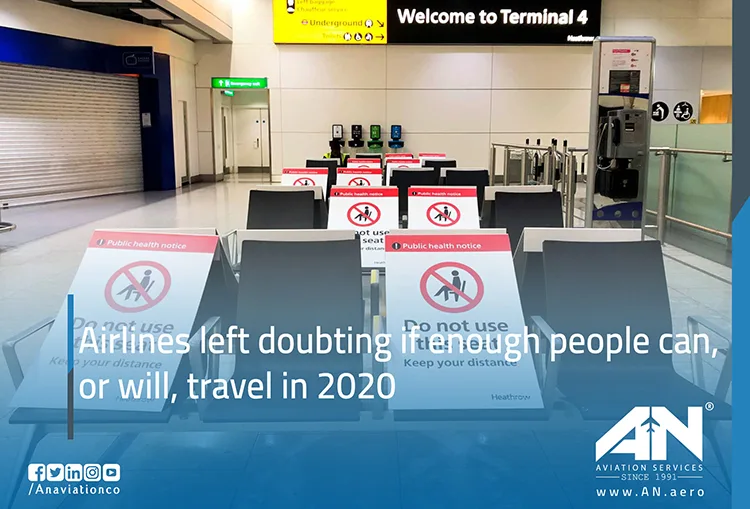
The year 2020 will be remembered as a time of unprecedented disruption for the aviation industry. With the COVID-19 pandemic affecting nearly every corner of the globe, airlines were left grappling with one critical question: would air travel demand recover enough to sustain their operations? The uncertainty surrounding passenger behavior, travel restrictions, and economic impacts forced airlines to reassess their forecasts and reimagine their strategies.
As air travel ground to a near halt in early 2020, the global passenger traffic forecasts painted a grim picture. Recovery would hinge on several factors, including the pace of reopening borders, the rollout of vaccines, and passengers’ willingness to take to the skies once again. Let’s explore why airlines faced such doubts and the factors that shaped air travel in this unprecedented year.
A Dramatic Decline in Air Travel Demand
At the heart of the crisis was the sharp decline in air travel demand, both international and domestic. With countries implementing strict lockdowns and closing borders, the international passenger market saw a record drop in traffic. Travel bans in regions like Asia Pacific, Europe, and North America further exacerbated the situation, pushing total passenger traffic to levels not seen in decades.
According to industry estimates, passenger numbers plummeted to about half of their 2019 levels, when airlines had carried over 4.5 billion passengers globally. This sharp contraction highlighted the aviation industry’s vulnerability to global crises. Airlines that had banked on year-on-year growth rates were suddenly struggling to fill planes, let alone meet their previous revenue targets.
Even domestic passenger markets, often seen as more resilient during global downturns, suffered significant setbacks. North America and Asia Pacific, which typically dominate domestic traffic, experienced sharp declines due to regional lockdowns and cautious consumer sentiment.
The Middle East and Latin America: Regional Struggles
While the pandemic impacted all regions, some faced even steeper challenges. The Middle East, a critical hub for connecting flights, saw its passenger traffic nosedive as long-haul flights became impractical. Airlines in this region, which had heavily invested in air transport infrastructure and relied on international transit passengers, struggled to adapt to a world with diminished demand.
Meanwhile, Latin America, a region with growing aviation markets, faced its own set of challenges. Economic slowdowns compounded the effects of the pandemic, further dampening air travel demand. Airlines in the region found themselves balancing operational costs with dwindling passenger numbers, leading to a wave of flight cancellations and downsizing.
Passenger Confidence: A Lingering Concern
One of the largest hurdles for airlines in 2020 was passenger confidence. Even as travel restrictions eased in some parts of the world, the fear of contracting COVID-19 during travel lingered. Passengers hesitated to board planes, particularly for international travel, where quarantine requirements and varying safety protocols created uncertainty.
While some countries introduced safety measures to rebuild confidence—like improved air filtration systems, onboard hygiene protocols, and pre-flight testing—these efforts weren’t enough to restore passenger numbers to their 2019 levels. Airlines were left wondering if air travel demand would recover fast enough to avoid long-term financial damage.
Traffic Forecasts Show Uncertainty
Throughout 2020, traffic forecasts from industry bodies like the International Air Transport Association (IATA) painted a mixed picture. While some domestic passenger markets showed signs of recovery during the latter half of the year, international passenger traffic lagged behind significantly.
Regions like Asia Pacific displayed some resilience due to their strong domestic markets, but international and domestic traffic in Europe and North America struggled to rebound. Airlines operating in these regions faced an uphill battle to meet even reduced demand projections.
By the end of 2020, global passenger traffic was expected to reach just 1.8 billion passengers, a stark contrast to the 4.5 billion carried in 2019. The growth rate of the aviation industry, once a beacon of economic progress, was now measured in slow, cautious steps rather than leaps.
Economic Pressures and Long-Term Implications
The uncertainty surrounding air travel in 2020 had broader implications for airlines’ financial health and operational strategies. Many airlines were forced to restructure their fleets, delay aircraft deliveries, and retire older planes to cut costs. For example, widebody planes that were once the backbone of long-haul air traffic were grounded indefinitely as demand for international flights evaporated.
This economic pressure extended to airline staff, with layoffs and furloughs becoming common across the industry. From pilots and cabin crew to ground staff, the ripple effects of reduced travel demand were felt at every level.
Hope on the Horizon?
Despite the challenges of 2020, there were glimmers of hope as the year progressed. The introduction of vaccines and the gradual reopening of borders in late 2020 signaled the possibility of recovery. Airlines also began exploring innovative ways to adapt, such as offering flexible ticketing policies, promoting domestic travel, and embracing air transport technologies to enhance safety and efficiency.
Furthermore, some regions saw a resurgence in domestic passenger traffic, with travelers opting for short-haul trips closer to home. This uptick provided a much-needed lifeline for airlines operating in markets like North America and Asia Pacific.
The Road to Recovery
As the aviation industry navigates its recovery, one thing is clear: the road ahead will require resilience, adaptability, and innovation. Airlines must continue to prioritize passenger safety, address confidence concerns, and embrace technologies that streamline the air travel experience.
While the uncertainties of 2020 left many airlines doubting whether enough people could—or would—travel, the industry’s history of overcoming challenges provides hope for the future. By learning from this crisis and reimagining their operations, airlines can emerge stronger and better equipped to handle future disruptions.

